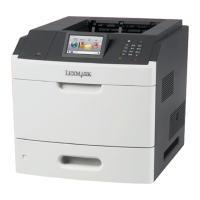Two-dimensional bar codes
56
Note: Byte Compaction Mode is sometimes referred to as Binary Compaction Mode.
Symbology ID bytes 1 and 2: (Required = 0001x)
These two bytes signify the symbology. Since most descriptors have different sizes and information,
all bar code descriptors must reserve the first two bytes for the symbology ID so the remaining bytes
can be interpreted accordingly. For PDF417, these two bytes must be 00x and 01x.
6–7 Y
dimension
byte 1 (in
Units)
Y
dimension
byte 2 (in
Units)
480–60000 (dec) 1890 (dec)
07 62 (hex)
Optional
Note: The range of values of the
Y dimension is between 2 to 5
times the values of the
X-dimension. Any value beyond
that range are clipped
appropriately and set to the
minimum and maximum values.
Sets the Y dimension of the
module (white or black
rectangle) in one-hundredths of
an inch.
The default width of this element
from the BCE is twice that of the
X dimension. To set the Y
dimension to default at 600 dpi
requires a value of 18.9, which
is specified as 1890 (dec) or 07
62 (hex).
The Units enumeration will be
set to 02 or 00 (hex), and these
two bytes will be 07 (hex) and
62 (hex). If not specified, then
the Y dimension will become
double that of the X dimension.
8–9 Rows Columns Rows: 4–44 (dec)
Columns: 1–4
(dec)
0 (dec)
00 (hex)
Optional
Manually set the number of
symbol rows. Automatic
operation specified by using 0.
See Section 9.5.3 Row and
Column Boundary Conditions.
Manually set the number of
symbol columns. Automatic
operation specified by using 0.
10–15 Reserved — — — —
Bytes MSB LSB Range
Default
(if not
specified)
Definition

